Biology Homework: Physiology and Digestive Processes Analysis
VerifiedAdded on 2020/07/23
|16
|3267
|33
Homework Assignment
AI Summary
This assignment provides a comprehensive overview of human physiology and digestive processes. It begins with an examination of the levels of organization in the human body and then explores various body systems, including the digestive, skeletal, and respiratory systems, detailing their functions and the tissues involved. The assignment delves into nutritional aspects, including the importance of vitamins like B12, the concept of a balanced diet, and the effects of nutritional deficiencies such as iron deficiency anemia, rickets, and scurvy. It further elucidates the breakdown processes of carbohydrates, fats, and proteins, including enzyme activation. The document also covers topics such as active transport of glucose, reflexes in the digestive system, the coordination of the nervous and endocrine systems, and homeostasis in relation to blood glucose. Additionally, it touches upon smooth muscles, connective tissues, and accessory organs in the digestive system. Finally, the document includes questions on hypochlorhydria, urine production, and the role of various processes in the body.
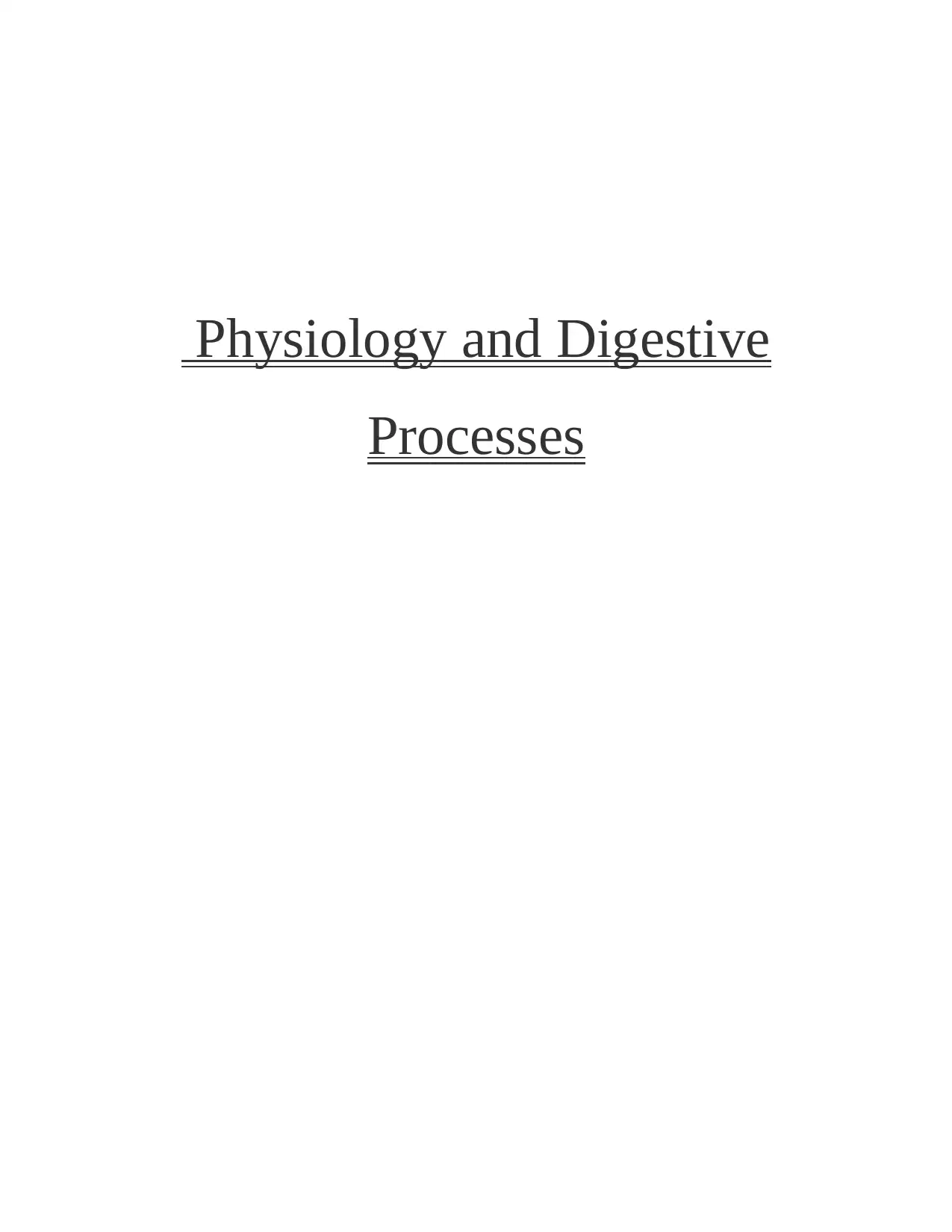
Physiology and Digestive
Processes
Processes
Paraphrase This Document
Need a fresh take? Get an instant paraphrase of this document with our AI Paraphraser
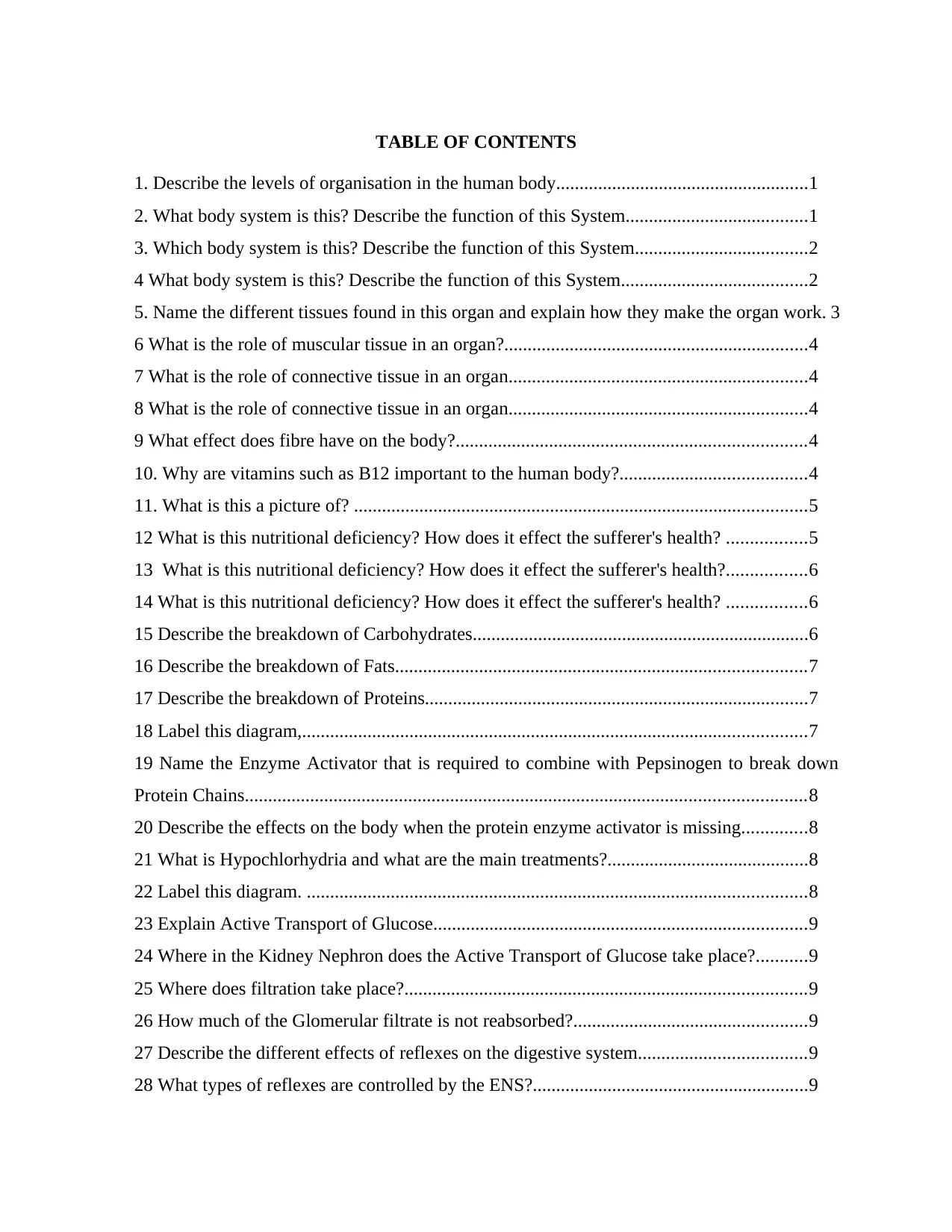
TABLE OF CONTENTS
1. Describe the levels of organisation in the human body......................................................1
2. What body system is this? Describe the function of this System.......................................1
3. Which body system is this? Describe the function of this System.....................................2
4 What body system is this? Describe the function of this System........................................2
5. Name the different tissues found in this organ and explain how they make the organ work. 3
6 What is the role of muscular tissue in an organ?.................................................................4
7 What is the role of connective tissue in an organ................................................................4
8 What is the role of connective tissue in an organ................................................................4
9 What effect does fibre have on the body?...........................................................................4
10. Why are vitamins such as B12 important to the human body?........................................4
11. What is this a picture of? .................................................................................................5
12 What is this nutritional deficiency? How does it effect the sufferer's health? .................5
13 What is this nutritional deficiency? How does it effect the sufferer's health?.................6
14 What is this nutritional deficiency? How does it effect the sufferer's health? .................6
15 Describe the breakdown of Carbohydrates........................................................................6
16 Describe the breakdown of Fats........................................................................................7
17 Describe the breakdown of Proteins..................................................................................7
18 Label this diagram,............................................................................................................7
19 Name the Enzyme Activator that is required to combine with Pepsinogen to break down
Protein Chains........................................................................................................................8
20 Describe the effects on the body when the protein enzyme activator is missing..............8
21 What is Hypochlorhydria and what are the main treatments?...........................................8
22 Label this diagram. ...........................................................................................................8
23 Explain Active Transport of Glucose................................................................................9
24 Where in the Kidney Nephron does the Active Transport of Glucose take place?...........9
25 Where does filtration take place?......................................................................................9
26 How much of the Glomerular filtrate is not reabsorbed?..................................................9
27 Describe the different effects of reflexes on the digestive system....................................9
28 What types of reflexes are controlled by the ENS?...........................................................9
1. Describe the levels of organisation in the human body......................................................1
2. What body system is this? Describe the function of this System.......................................1
3. Which body system is this? Describe the function of this System.....................................2
4 What body system is this? Describe the function of this System........................................2
5. Name the different tissues found in this organ and explain how they make the organ work. 3
6 What is the role of muscular tissue in an organ?.................................................................4
7 What is the role of connective tissue in an organ................................................................4
8 What is the role of connective tissue in an organ................................................................4
9 What effect does fibre have on the body?...........................................................................4
10. Why are vitamins such as B12 important to the human body?........................................4
11. What is this a picture of? .................................................................................................5
12 What is this nutritional deficiency? How does it effect the sufferer's health? .................5
13 What is this nutritional deficiency? How does it effect the sufferer's health?.................6
14 What is this nutritional deficiency? How does it effect the sufferer's health? .................6
15 Describe the breakdown of Carbohydrates........................................................................6
16 Describe the breakdown of Fats........................................................................................7
17 Describe the breakdown of Proteins..................................................................................7
18 Label this diagram,............................................................................................................7
19 Name the Enzyme Activator that is required to combine with Pepsinogen to break down
Protein Chains........................................................................................................................8
20 Describe the effects on the body when the protein enzyme activator is missing..............8
21 What is Hypochlorhydria and what are the main treatments?...........................................8
22 Label this diagram. ...........................................................................................................8
23 Explain Active Transport of Glucose................................................................................9
24 Where in the Kidney Nephron does the Active Transport of Glucose take place?...........9
25 Where does filtration take place?......................................................................................9
26 How much of the Glomerular filtrate is not reabsorbed?..................................................9
27 Describe the different effects of reflexes on the digestive system....................................9
28 What types of reflexes are controlled by the ENS?...........................................................9
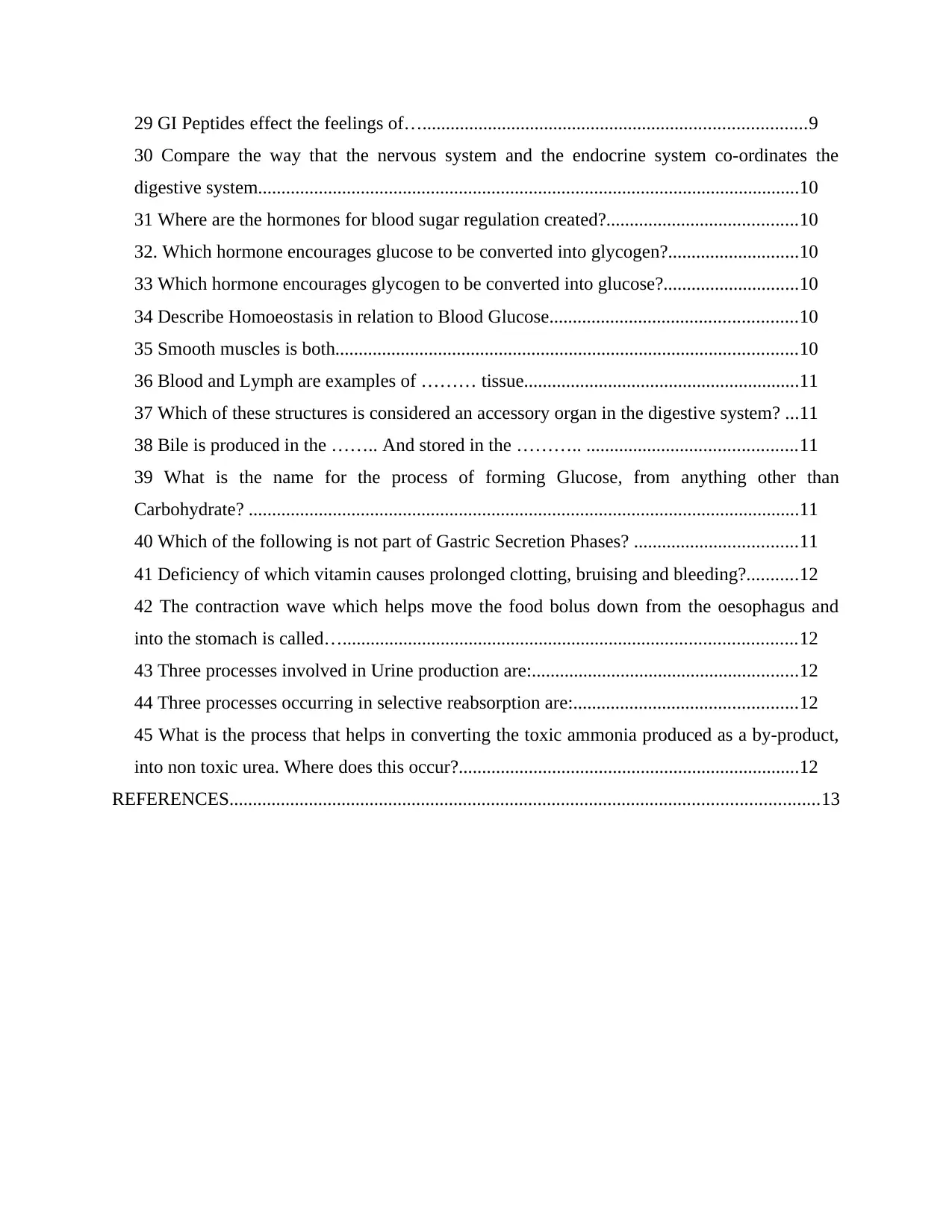
29 GI Peptides effect the feelings of…..................................................................................9
30 Compare the way that the nervous system and the endocrine system co-ordinates the
digestive system....................................................................................................................10
31 Where are the hormones for blood sugar regulation created?.........................................10
32. Which hormone encourages glucose to be converted into glycogen?............................10
33 Which hormone encourages glycogen to be converted into glucose?.............................10
34 Describe Homoeostasis in relation to Blood Glucose.....................................................10
35 Smooth muscles is both...................................................................................................10
36 Blood and Lymph are examples of ……… tissue...........................................................11
37 Which of these structures is considered an accessory organ in the digestive system? ...11
38 Bile is produced in the …….. And stored in the ……….. .............................................11
39 What is the name for the process of forming Glucose, from anything other than
Carbohydrate? ......................................................................................................................11
40 Which of the following is not part of Gastric Secretion Phases? ...................................11
41 Deficiency of which vitamin causes prolonged clotting, bruising and bleeding?...........12
42 The contraction wave which helps move the food bolus down from the oesophagus and
into the stomach is called….................................................................................................12
43 Three processes involved in Urine production are:.........................................................12
44 Three processes occurring in selective reabsorption are:................................................12
45 What is the process that helps in converting the toxic ammonia produced as a by-product,
into non toxic urea. Where does this occur?.........................................................................12
REFERENCES..............................................................................................................................13
30 Compare the way that the nervous system and the endocrine system co-ordinates the
digestive system....................................................................................................................10
31 Where are the hormones for blood sugar regulation created?.........................................10
32. Which hormone encourages glucose to be converted into glycogen?............................10
33 Which hormone encourages glycogen to be converted into glucose?.............................10
34 Describe Homoeostasis in relation to Blood Glucose.....................................................10
35 Smooth muscles is both...................................................................................................10
36 Blood and Lymph are examples of ……… tissue...........................................................11
37 Which of these structures is considered an accessory organ in the digestive system? ...11
38 Bile is produced in the …….. And stored in the ……….. .............................................11
39 What is the name for the process of forming Glucose, from anything other than
Carbohydrate? ......................................................................................................................11
40 Which of the following is not part of Gastric Secretion Phases? ...................................11
41 Deficiency of which vitamin causes prolonged clotting, bruising and bleeding?...........12
42 The contraction wave which helps move the food bolus down from the oesophagus and
into the stomach is called….................................................................................................12
43 Three processes involved in Urine production are:.........................................................12
44 Three processes occurring in selective reabsorption are:................................................12
45 What is the process that helps in converting the toxic ammonia produced as a by-product,
into non toxic urea. Where does this occur?.........................................................................12
REFERENCES..............................................................................................................................13
⊘ This is a preview!⊘
Do you want full access?
Subscribe today to unlock all pages.

Trusted by 1+ million students worldwide
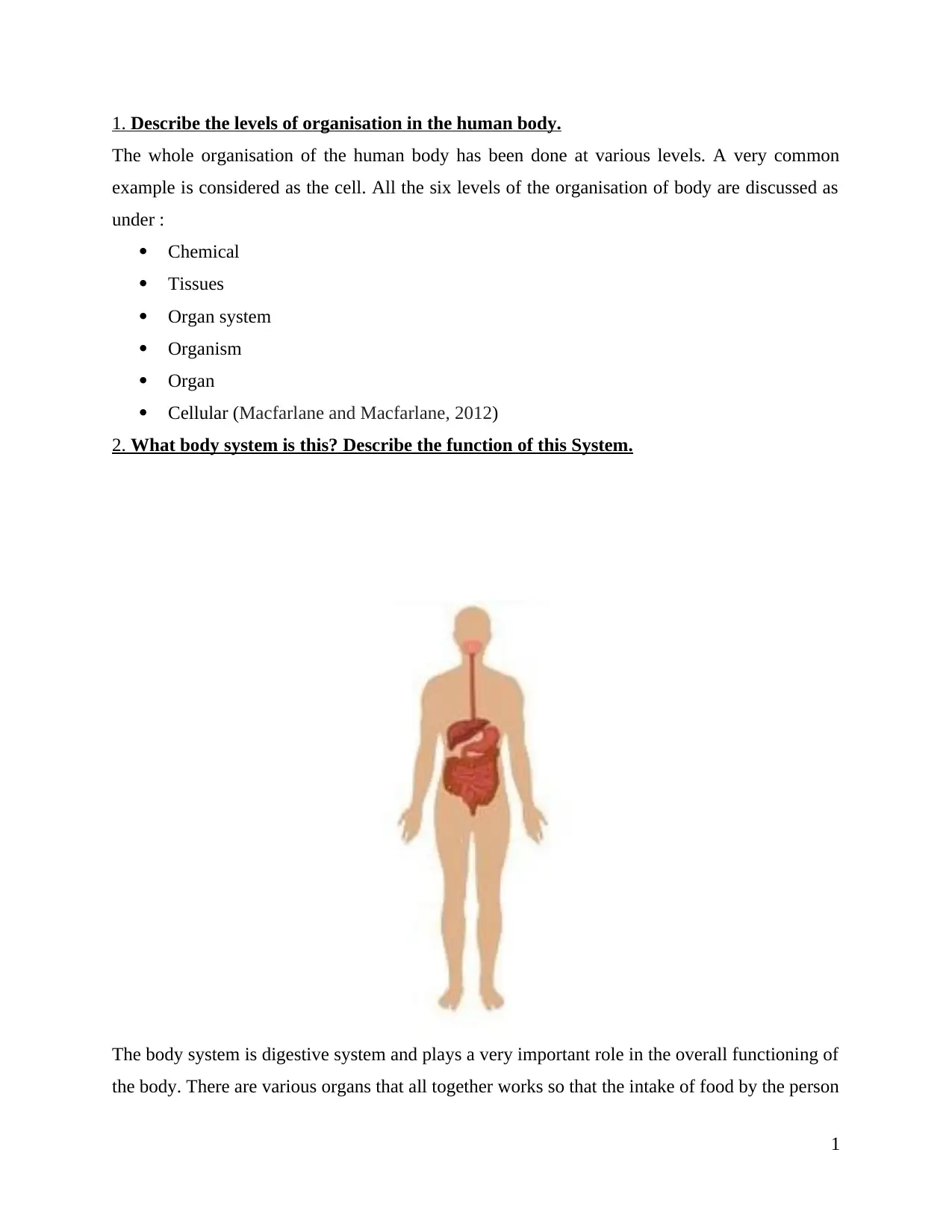
1. Describe the levels of organisation in the human body.
The whole organisation of the human body has been done at various levels. A very common
example is considered as the cell. All the six levels of the organisation of body are discussed as
under :
Chemical
Tissues
Organ system
Organism
Organ
Cellular (Macfarlane and Macfarlane, 2012)
2. What body system is this? Describe the function of this System.
The body system is digestive system and plays a very important role in the overall functioning of
the body. There are various organs that all together works so that the intake of food by the person
1
The whole organisation of the human body has been done at various levels. A very common
example is considered as the cell. All the six levels of the organisation of body are discussed as
under :
Chemical
Tissues
Organ system
Organism
Organ
Cellular (Macfarlane and Macfarlane, 2012)
2. What body system is this? Describe the function of this System.
The body system is digestive system and plays a very important role in the overall functioning of
the body. There are various organs that all together works so that the intake of food by the person
1
Paraphrase This Document
Need a fresh take? Get an instant paraphrase of this document with our AI Paraphraser
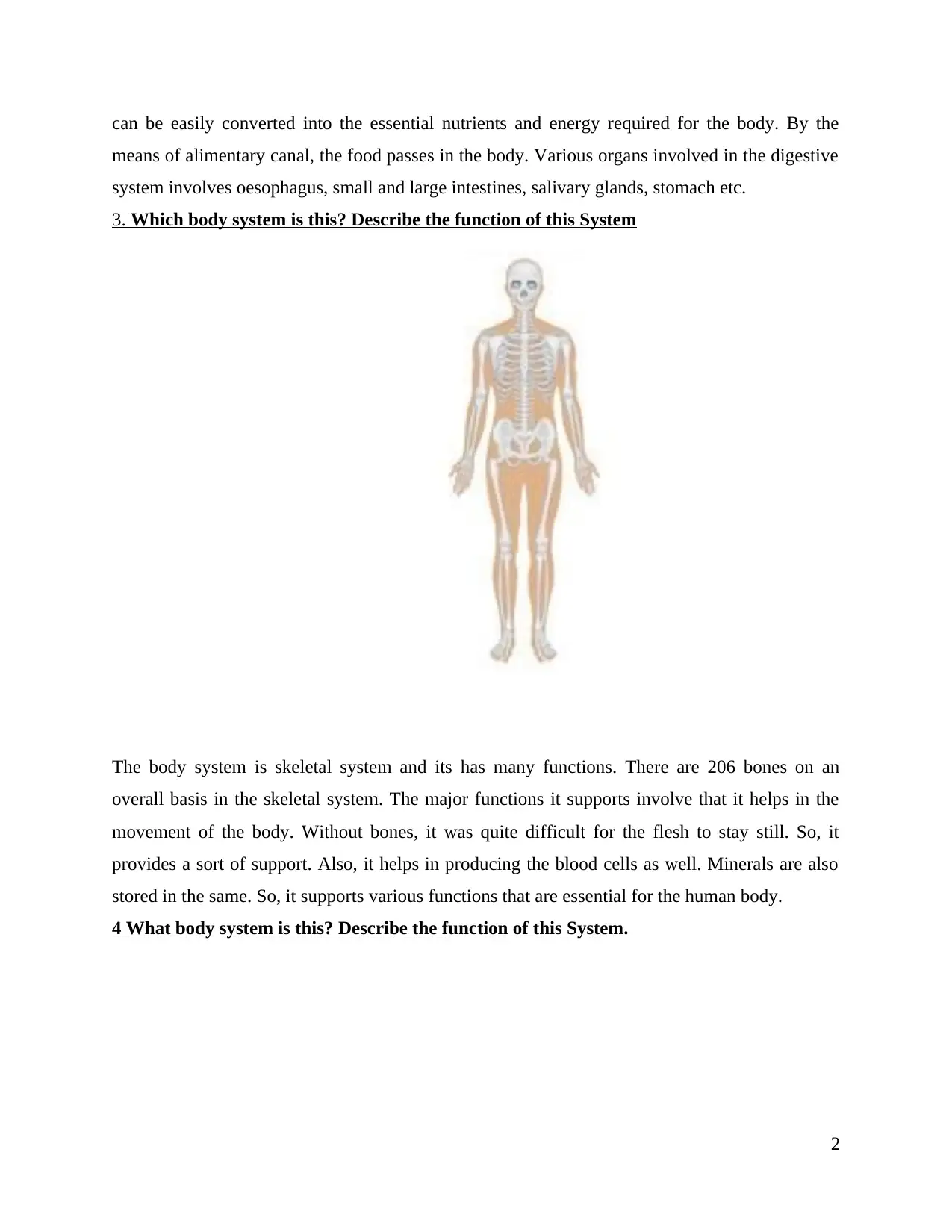
can be easily converted into the essential nutrients and energy required for the body. By the
means of alimentary canal, the food passes in the body. Various organs involved in the digestive
system involves oesophagus, small and large intestines, salivary glands, stomach etc.
3. Which body system is this? Describe the function of this System
The body system is skeletal system and its has many functions. There are 206 bones on an
overall basis in the skeletal system. The major functions it supports involve that it helps in the
movement of the body. Without bones, it was quite difficult for the flesh to stay still. So, it
provides a sort of support. Also, it helps in producing the blood cells as well. Minerals are also
stored in the same. So, it supports various functions that are essential for the human body.
4 What body system is this? Describe the function of this System.
2
means of alimentary canal, the food passes in the body. Various organs involved in the digestive
system involves oesophagus, small and large intestines, salivary glands, stomach etc.
3. Which body system is this? Describe the function of this System
The body system is skeletal system and its has many functions. There are 206 bones on an
overall basis in the skeletal system. The major functions it supports involve that it helps in the
movement of the body. Without bones, it was quite difficult for the flesh to stay still. So, it
provides a sort of support. Also, it helps in producing the blood cells as well. Minerals are also
stored in the same. So, it supports various functions that are essential for the human body.
4 What body system is this? Describe the function of this System.
2
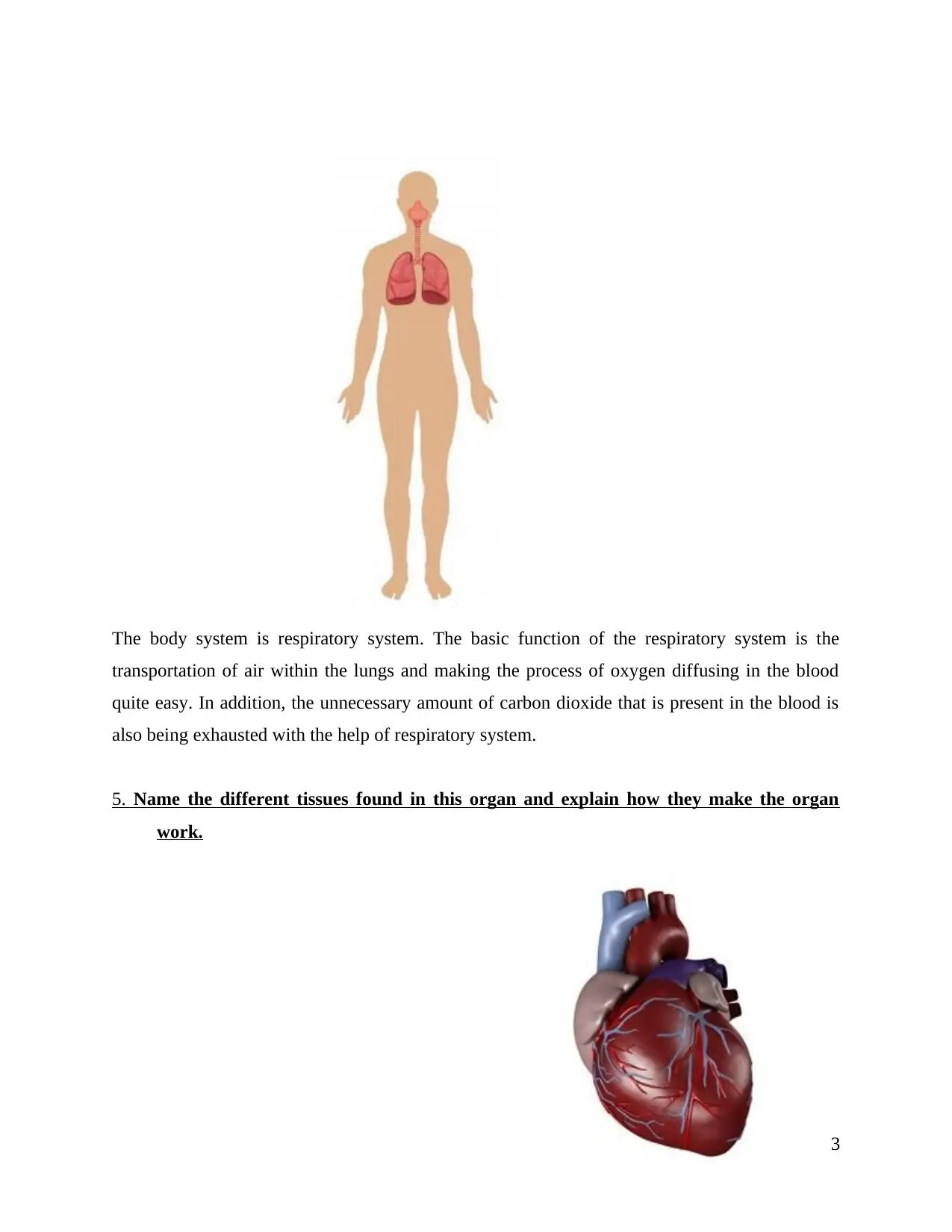
The body system is respiratory system. The basic function of the respiratory system is the
transportation of air within the lungs and making the process of oxygen diffusing in the blood
quite easy. In addition, the unnecessary amount of carbon dioxide that is present in the blood is
also being exhausted with the help of respiratory system.
5. Name the different tissues found in this organ and explain how they make the organ
work.
3
transportation of air within the lungs and making the process of oxygen diffusing in the blood
quite easy. In addition, the unnecessary amount of carbon dioxide that is present in the blood is
also being exhausted with the help of respiratory system.
5. Name the different tissues found in this organ and explain how they make the organ
work.
3
⊘ This is a preview!⊘
Do you want full access?
Subscribe today to unlock all pages.

Trusted by 1+ million students worldwide
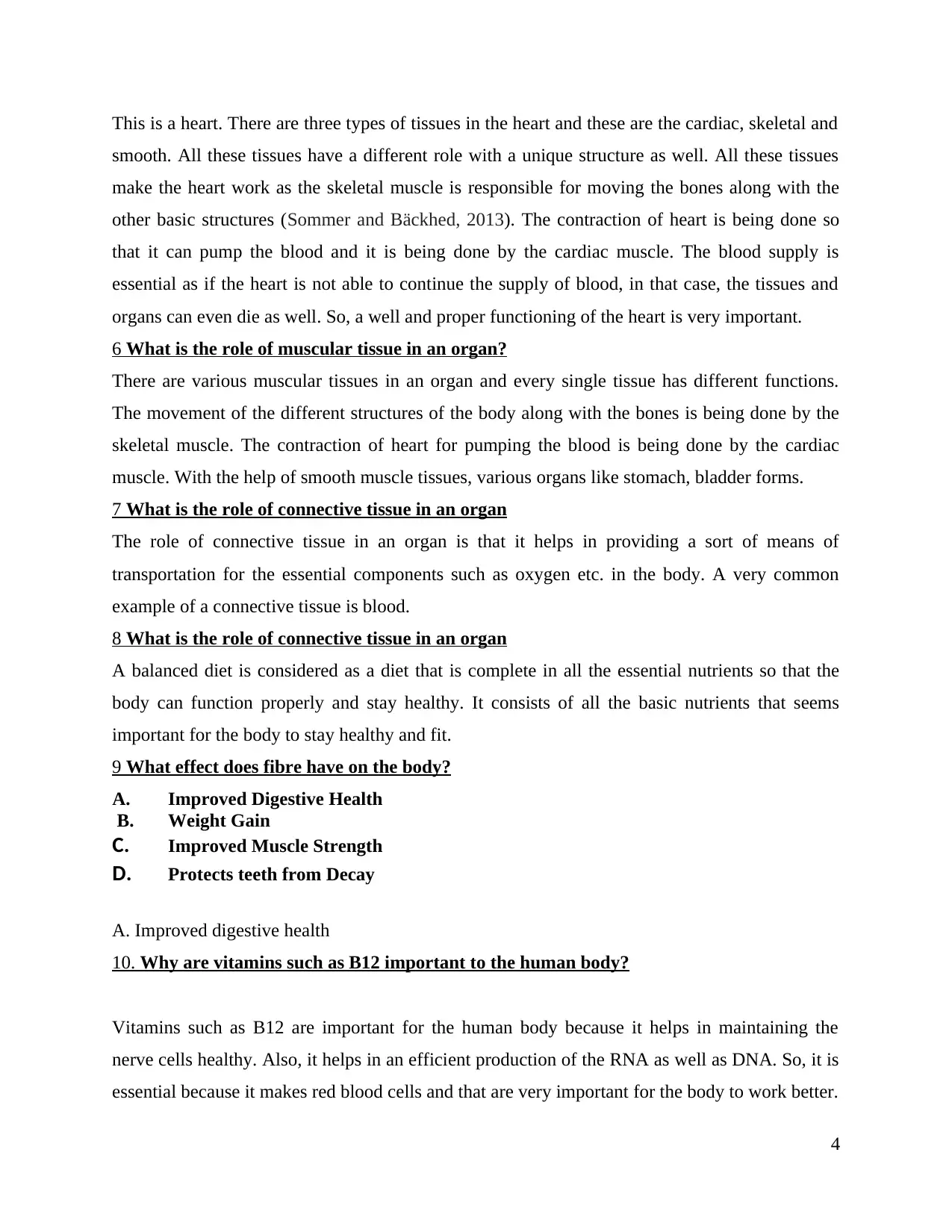
This is a heart. There are three types of tissues in the heart and these are the cardiac, skeletal and
smooth. All these tissues have a different role with a unique structure as well. All these tissues
make the heart work as the skeletal muscle is responsible for moving the bones along with the
other basic structures (Sommer and Bäckhed, 2013). The contraction of heart is being done so
that it can pump the blood and it is being done by the cardiac muscle. The blood supply is
essential as if the heart is not able to continue the supply of blood, in that case, the tissues and
organs can even die as well. So, a well and proper functioning of the heart is very important.
6 What is the role of muscular tissue in an organ?
There are various muscular tissues in an organ and every single tissue has different functions.
The movement of the different structures of the body along with the bones is being done by the
skeletal muscle. The contraction of heart for pumping the blood is being done by the cardiac
muscle. With the help of smooth muscle tissues, various organs like stomach, bladder forms.
7 What is the role of connective tissue in an organ
The role of connective tissue in an organ is that it helps in providing a sort of means of
transportation for the essential components such as oxygen etc. in the body. A very common
example of a connective tissue is blood.
8 What is the role of connective tissue in an organ
A balanced diet is considered as a diet that is complete in all the essential nutrients so that the
body can function properly and stay healthy. It consists of all the basic nutrients that seems
important for the body to stay healthy and fit.
9 What effect does fibre have on the body?
A. Improved Digestive Health
B. Weight Gain
C. Improved Muscle Strength
D. Protects teeth from Decay
A. Improved digestive health
10. Why are vitamins such as B12 important to the human body?
Vitamins such as B12 are important for the human body because it helps in maintaining the
nerve cells healthy. Also, it helps in an efficient production of the RNA as well as DNA. So, it is
essential because it makes red blood cells and that are very important for the body to work better.
4
smooth. All these tissues have a different role with a unique structure as well. All these tissues
make the heart work as the skeletal muscle is responsible for moving the bones along with the
other basic structures (Sommer and Bäckhed, 2013). The contraction of heart is being done so
that it can pump the blood and it is being done by the cardiac muscle. The blood supply is
essential as if the heart is not able to continue the supply of blood, in that case, the tissues and
organs can even die as well. So, a well and proper functioning of the heart is very important.
6 What is the role of muscular tissue in an organ?
There are various muscular tissues in an organ and every single tissue has different functions.
The movement of the different structures of the body along with the bones is being done by the
skeletal muscle. The contraction of heart for pumping the blood is being done by the cardiac
muscle. With the help of smooth muscle tissues, various organs like stomach, bladder forms.
7 What is the role of connective tissue in an organ
The role of connective tissue in an organ is that it helps in providing a sort of means of
transportation for the essential components such as oxygen etc. in the body. A very common
example of a connective tissue is blood.
8 What is the role of connective tissue in an organ
A balanced diet is considered as a diet that is complete in all the essential nutrients so that the
body can function properly and stay healthy. It consists of all the basic nutrients that seems
important for the body to stay healthy and fit.
9 What effect does fibre have on the body?
A. Improved Digestive Health
B. Weight Gain
C. Improved Muscle Strength
D. Protects teeth from Decay
A. Improved digestive health
10. Why are vitamins such as B12 important to the human body?
Vitamins such as B12 are important for the human body because it helps in maintaining the
nerve cells healthy. Also, it helps in an efficient production of the RNA as well as DNA. So, it is
essential because it makes red blood cells and that are very important for the body to work better.
4
Paraphrase This Document
Need a fresh take? Get an instant paraphrase of this document with our AI Paraphraser
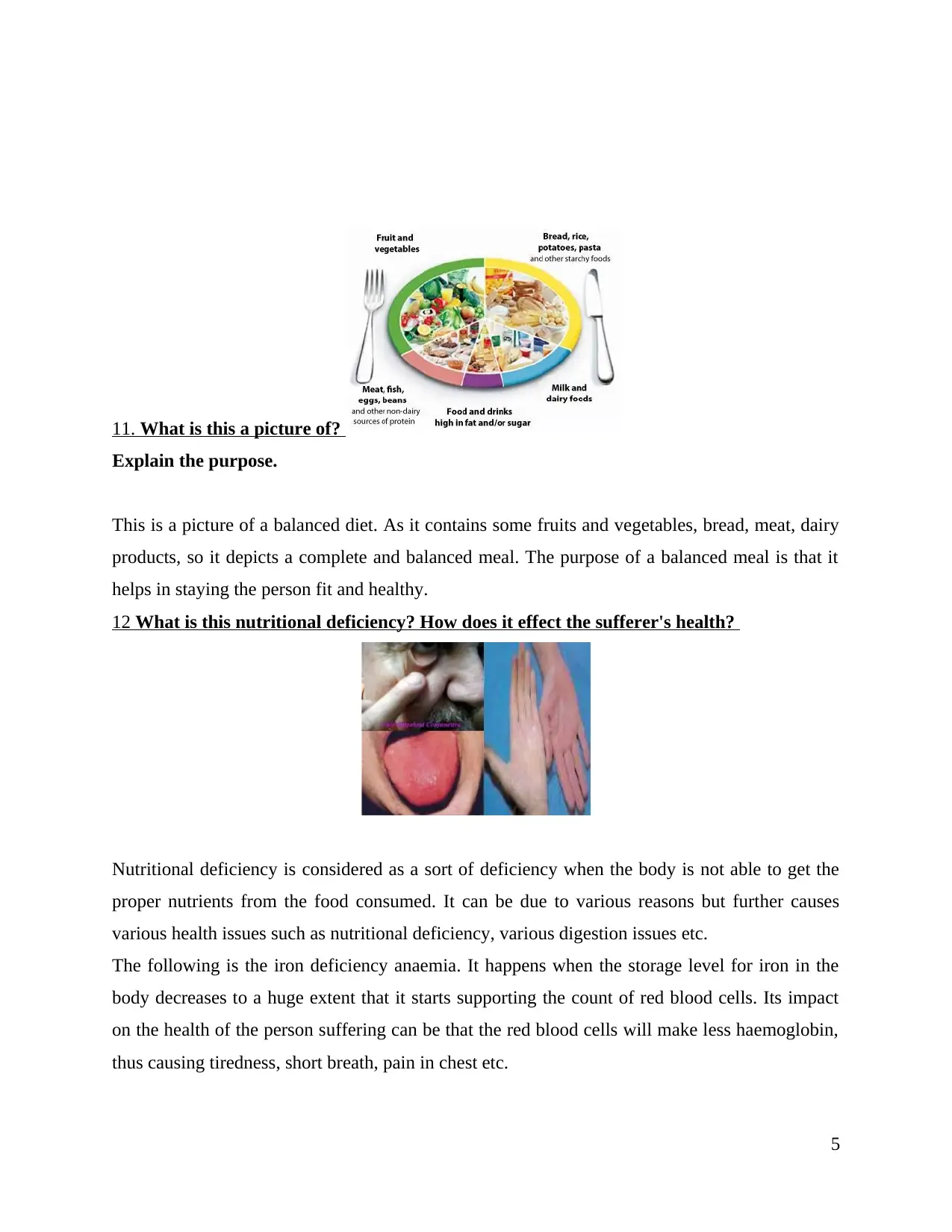
11. What is this a picture of?
Explain the purpose.
This is a picture of a balanced diet. As it contains some fruits and vegetables, bread, meat, dairy
products, so it depicts a complete and balanced meal. The purpose of a balanced meal is that it
helps in staying the person fit and healthy.
12 What is this nutritional deficiency? How does it effect the sufferer's health?
Nutritional deficiency is considered as a sort of deficiency when the body is not able to get the
proper nutrients from the food consumed. It can be due to various reasons but further causes
various health issues such as nutritional deficiency, various digestion issues etc.
The following is the iron deficiency anaemia. It happens when the storage level for iron in the
body decreases to a huge extent that it starts supporting the count of red blood cells. Its impact
on the health of the person suffering can be that the red blood cells will make less haemoglobin,
thus causing tiredness, short breath, pain in chest etc.
5
Explain the purpose.
This is a picture of a balanced diet. As it contains some fruits and vegetables, bread, meat, dairy
products, so it depicts a complete and balanced meal. The purpose of a balanced meal is that it
helps in staying the person fit and healthy.
12 What is this nutritional deficiency? How does it effect the sufferer's health?
Nutritional deficiency is considered as a sort of deficiency when the body is not able to get the
proper nutrients from the food consumed. It can be due to various reasons but further causes
various health issues such as nutritional deficiency, various digestion issues etc.
The following is the iron deficiency anaemia. It happens when the storage level for iron in the
body decreases to a huge extent that it starts supporting the count of red blood cells. Its impact
on the health of the person suffering can be that the red blood cells will make less haemoglobin,
thus causing tiredness, short breath, pain in chest etc.
5
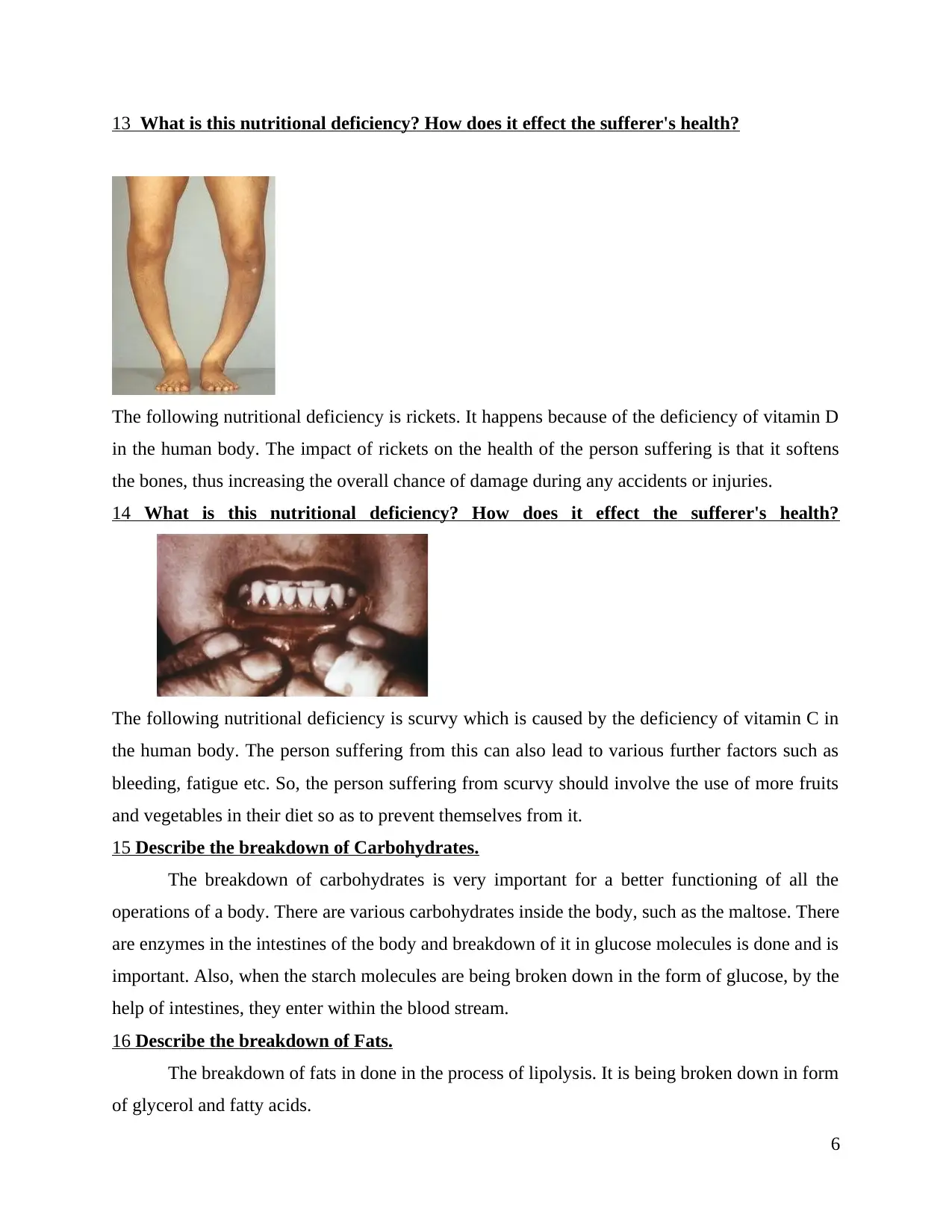
13 What is this nutritional deficiency? How does it effect the sufferer's health?
The following nutritional deficiency is rickets. It happens because of the deficiency of vitamin D
in the human body. The impact of rickets on the health of the person suffering is that it softens
the bones, thus increasing the overall chance of damage during any accidents or injuries.
14 What is this nutritional deficiency? How does it effect the sufferer's health?
The following nutritional deficiency is scurvy which is caused by the deficiency of vitamin C in
the human body. The person suffering from this can also lead to various further factors such as
bleeding, fatigue etc. So, the person suffering from scurvy should involve the use of more fruits
and vegetables in their diet so as to prevent themselves from it.
15 Describe the breakdown of Carbohydrates.
The breakdown of carbohydrates is very important for a better functioning of all the
operations of a body. There are various carbohydrates inside the body, such as the maltose. There
are enzymes in the intestines of the body and breakdown of it in glucose molecules is done and is
important. Also, when the starch molecules are being broken down in the form of glucose, by the
help of intestines, they enter within the blood stream.
16 Describe the breakdown of Fats.
The breakdown of fats in done in the process of lipolysis. It is being broken down in form
of glycerol and fatty acids.
6
The following nutritional deficiency is rickets. It happens because of the deficiency of vitamin D
in the human body. The impact of rickets on the health of the person suffering is that it softens
the bones, thus increasing the overall chance of damage during any accidents or injuries.
14 What is this nutritional deficiency? How does it effect the sufferer's health?
The following nutritional deficiency is scurvy which is caused by the deficiency of vitamin C in
the human body. The person suffering from this can also lead to various further factors such as
bleeding, fatigue etc. So, the person suffering from scurvy should involve the use of more fruits
and vegetables in their diet so as to prevent themselves from it.
15 Describe the breakdown of Carbohydrates.
The breakdown of carbohydrates is very important for a better functioning of all the
operations of a body. There are various carbohydrates inside the body, such as the maltose. There
are enzymes in the intestines of the body and breakdown of it in glucose molecules is done and is
important. Also, when the starch molecules are being broken down in the form of glucose, by the
help of intestines, they enter within the blood stream.
16 Describe the breakdown of Fats.
The breakdown of fats in done in the process of lipolysis. It is being broken down in form
of glycerol and fatty acids.
6
⊘ This is a preview!⊘
Do you want full access?
Subscribe today to unlock all pages.

Trusted by 1+ million students worldwide
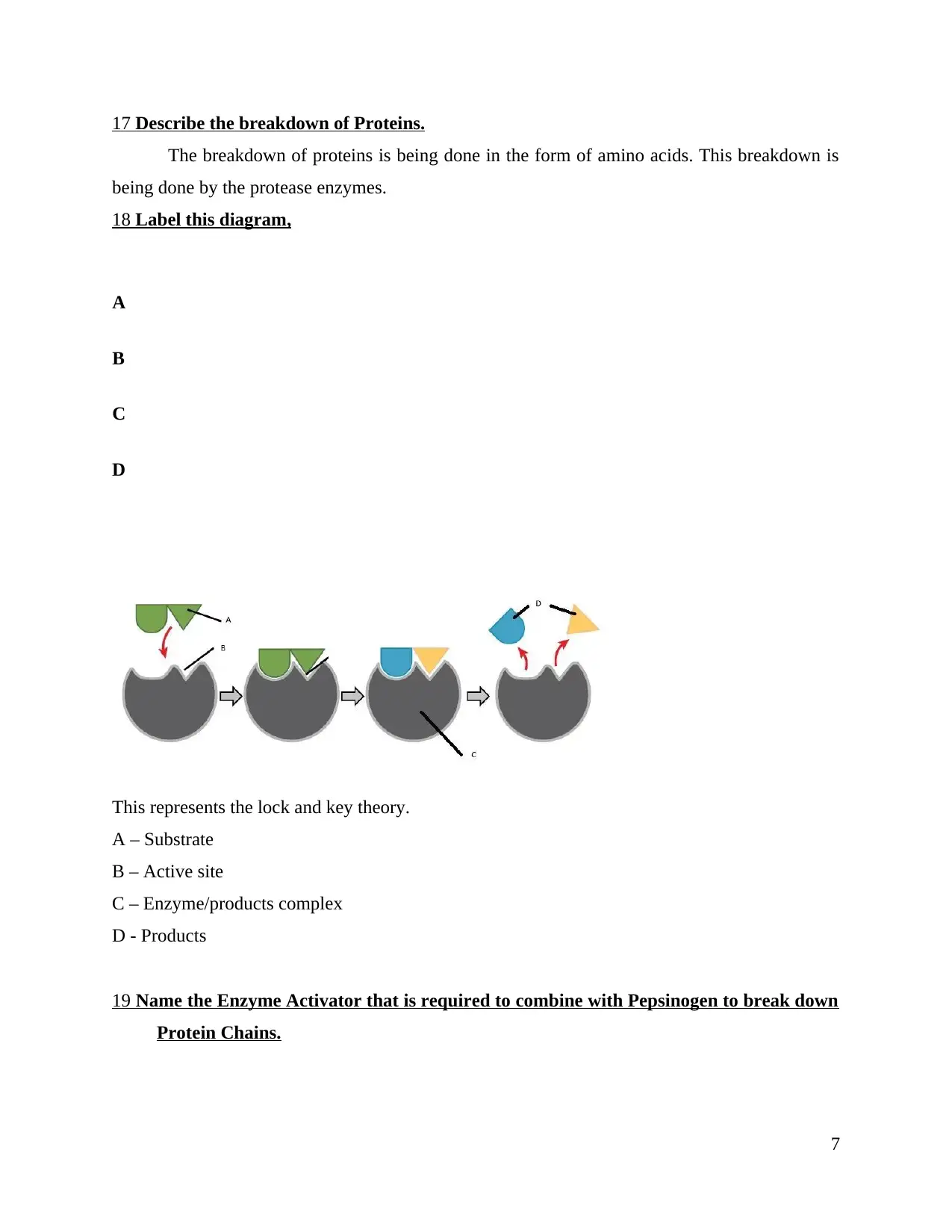
17 Describe the breakdown of Proteins.
The breakdown of proteins is being done in the form of amino acids. This breakdown is
being done by the protease enzymes.
18 Label this diagram,
A
B
C
D
This represents the lock and key theory.
A – Substrate
B – Active site
C – Enzyme/products complex
D - Products
19 Name the Enzyme Activator that is required to combine with Pepsinogen to break down
Protein Chains.
7
The breakdown of proteins is being done in the form of amino acids. This breakdown is
being done by the protease enzymes.
18 Label this diagram,
A
B
C
D
This represents the lock and key theory.
A – Substrate
B – Active site
C – Enzyme/products complex
D - Products
19 Name the Enzyme Activator that is required to combine with Pepsinogen to break down
Protein Chains.
7
Paraphrase This Document
Need a fresh take? Get an instant paraphrase of this document with our AI Paraphraser
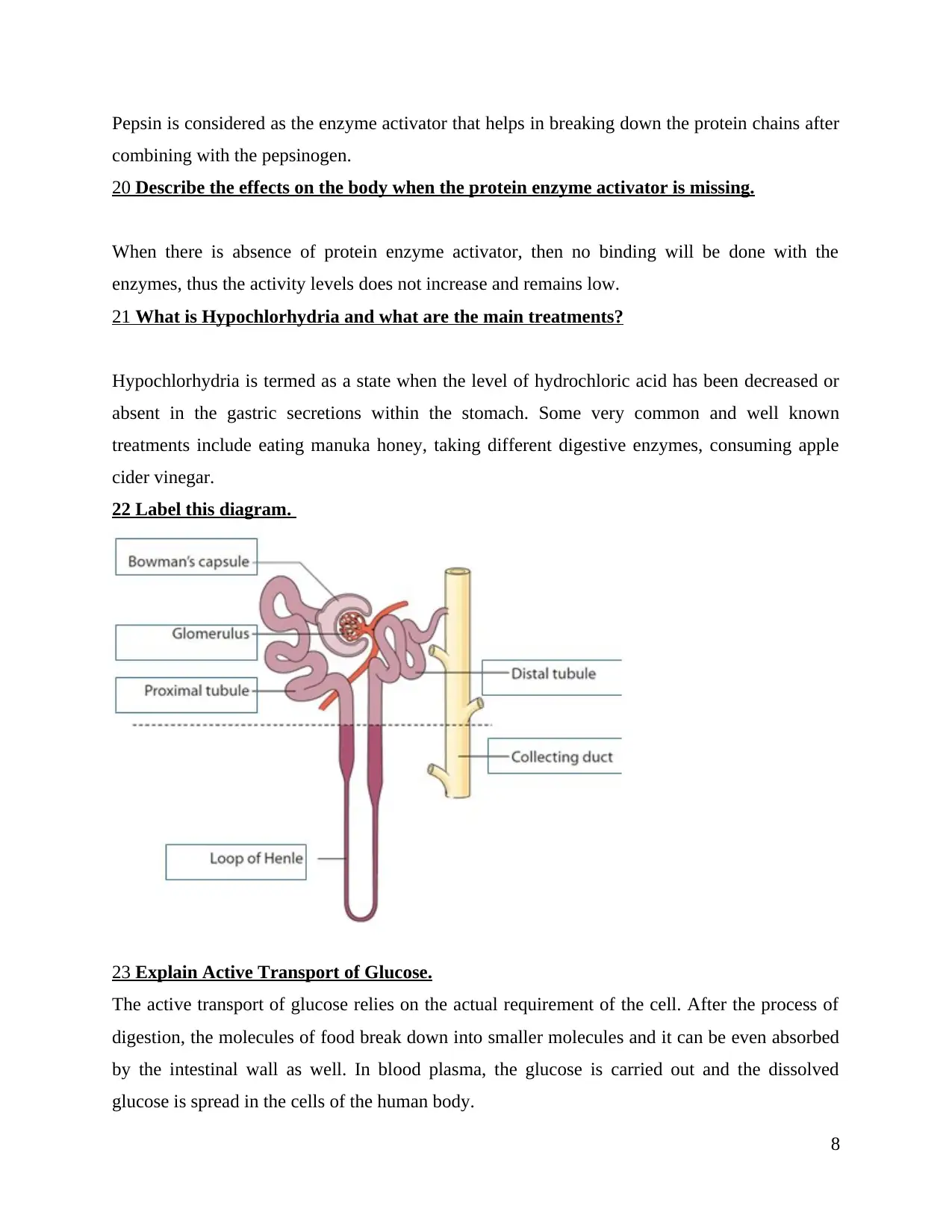
Pepsin is considered as the enzyme activator that helps in breaking down the protein chains after
combining with the pepsinogen.
20 Describe the effects on the body when the protein enzyme activator is missing.
When there is absence of protein enzyme activator, then no binding will be done with the
enzymes, thus the activity levels does not increase and remains low.
21 What is Hypochlorhydria and what are the main treatments?
Hypochlorhydria is termed as a state when the level of hydrochloric acid has been decreased or
absent in the gastric secretions within the stomach. Some very common and well known
treatments include eating manuka honey, taking different digestive enzymes, consuming apple
cider vinegar.
22 Label this diagram.
23 Explain Active Transport of Glucose.
The active transport of glucose relies on the actual requirement of the cell. After the process of
digestion, the molecules of food break down into smaller molecules and it can be even absorbed
by the intestinal wall as well. In blood plasma, the glucose is carried out and the dissolved
glucose is spread in the cells of the human body.
8
combining with the pepsinogen.
20 Describe the effects on the body when the protein enzyme activator is missing.
When there is absence of protein enzyme activator, then no binding will be done with the
enzymes, thus the activity levels does not increase and remains low.
21 What is Hypochlorhydria and what are the main treatments?
Hypochlorhydria is termed as a state when the level of hydrochloric acid has been decreased or
absent in the gastric secretions within the stomach. Some very common and well known
treatments include eating manuka honey, taking different digestive enzymes, consuming apple
cider vinegar.
22 Label this diagram.
23 Explain Active Transport of Glucose.
The active transport of glucose relies on the actual requirement of the cell. After the process of
digestion, the molecules of food break down into smaller molecules and it can be even absorbed
by the intestinal wall as well. In blood plasma, the glucose is carried out and the dissolved
glucose is spread in the cells of the human body.
8
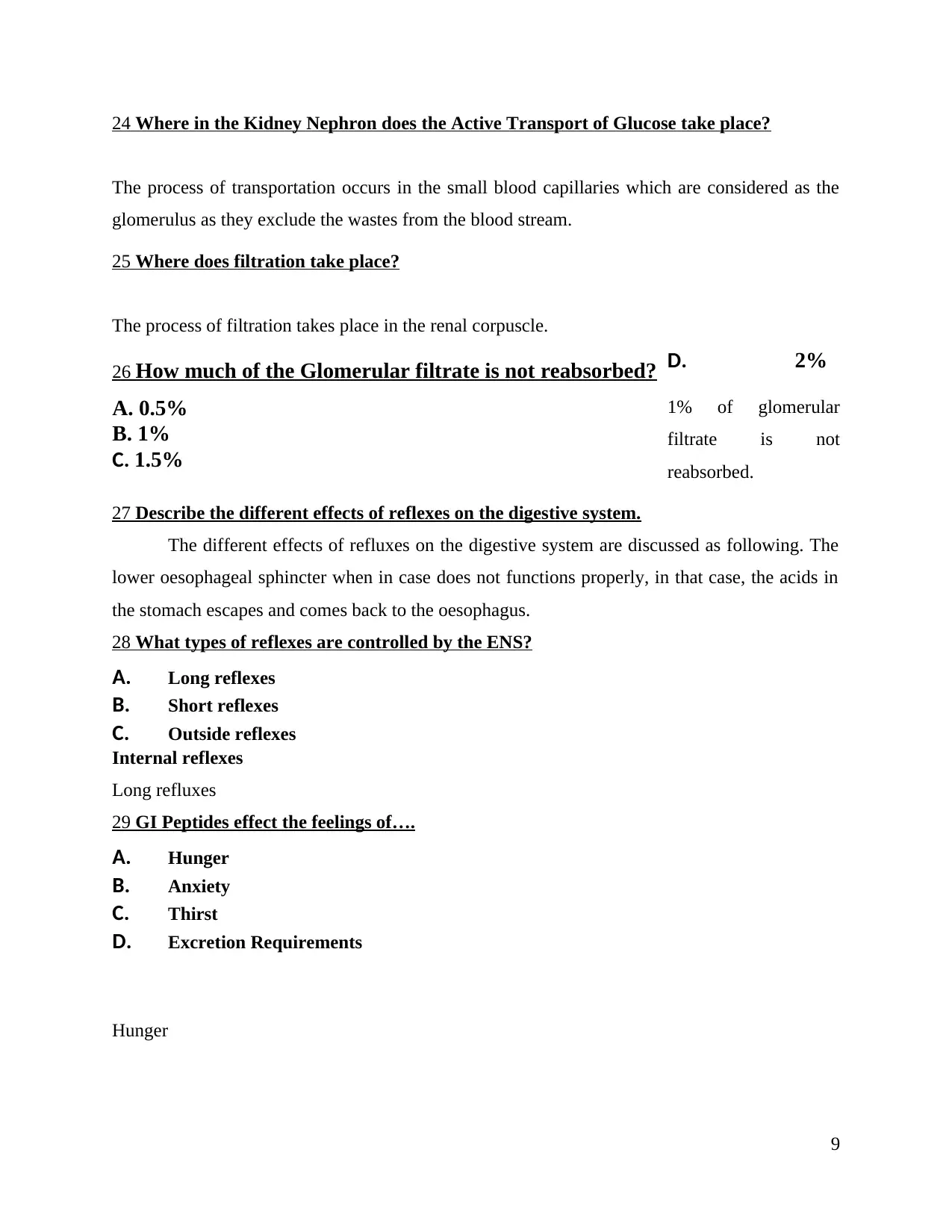
24 Where in the Kidney Nephron does the Active Transport of Glucose take place?
The process of transportation occurs in the small blood capillaries which are considered as the
glomerulus as they exclude the wastes from the blood stream.
25 Where does filtration take place?
The process of filtration takes place in the renal corpuscle.
D. 2%
1% of glomerular
filtrate is not
reabsorbed.
27 Describe the different effects of reflexes on the digestive system.
The different effects of refluxes on the digestive system are discussed as following. The
lower oesophageal sphincter when in case does not functions properly, in that case, the acids in
the stomach escapes and comes back to the oesophagus.
28 What types of reflexes are controlled by the ENS?
A. Long reflexes
B. Short reflexes
C. Outside reflexes
Internal reflexes
Long refluxes
29 GI Peptides effect the feelings of….
A. Hunger
B. Anxiety
C. Thirst
D. Excretion Requirements
Hunger
9
26 How much of the Glomerular filtrate is not reabsorbed?
A. 0.5%
B. 1%
C. 1.5%
The process of transportation occurs in the small blood capillaries which are considered as the
glomerulus as they exclude the wastes from the blood stream.
25 Where does filtration take place?
The process of filtration takes place in the renal corpuscle.
D. 2%
1% of glomerular
filtrate is not
reabsorbed.
27 Describe the different effects of reflexes on the digestive system.
The different effects of refluxes on the digestive system are discussed as following. The
lower oesophageal sphincter when in case does not functions properly, in that case, the acids in
the stomach escapes and comes back to the oesophagus.
28 What types of reflexes are controlled by the ENS?
A. Long reflexes
B. Short reflexes
C. Outside reflexes
Internal reflexes
Long refluxes
29 GI Peptides effect the feelings of….
A. Hunger
B. Anxiety
C. Thirst
D. Excretion Requirements
Hunger
9
26 How much of the Glomerular filtrate is not reabsorbed?
A. 0.5%
B. 1%
C. 1.5%
⊘ This is a preview!⊘
Do you want full access?
Subscribe today to unlock all pages.

Trusted by 1+ million students worldwide
1 out of 16
Related Documents
Your All-in-One AI-Powered Toolkit for Academic Success.
+13062052269
info@desklib.com
Available 24*7 on WhatsApp / Email
![[object Object]](/_next/static/media/star-bottom.7253800d.svg)
Unlock your academic potential
Copyright © 2020–2025 A2Z Services. All Rights Reserved. Developed and managed by ZUCOL.





